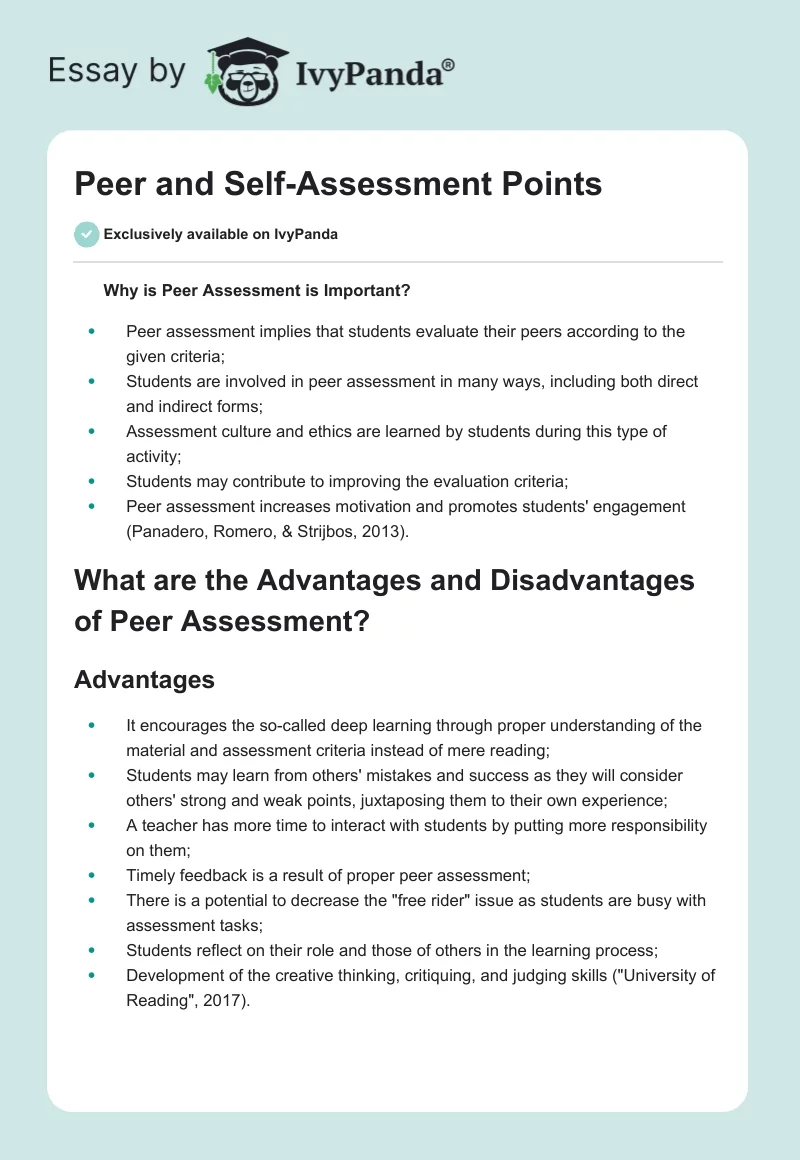Why is Peer Assessment Important?
- Peer assessment implies that students evaluate their peers according to the given criteria;
- Students are involved in peer assessment in many ways, including both direct and indirect forms;
- Assessment culture and ethics are learned by students during this type of activity;
- Students may contribute to improving the evaluation criteria;
- Peer assessment increases motivation and promotes students’ engagement (Panadero, Romero, & Strijbos, 2013).
What Are the Advantages and Disadvantages of Peer Assessment?
Advantages
- It encourages the so-called deep learning through proper understanding of the material and assessment criteria instead of mere reading;
- Students may learn from others’ mistakes and success as they will consider others’ strong and weak points, juxtaposing them to their own experience;
- A teacher has more time to interact with students by putting more responsibility on them;
- Timely feedback is a result of proper peer assessment;
- There is a potential to decrease the “free rider” issue as students are busy with assessment tasks;
- Students reflect on their role and those of others in the learning process;
- Development of the creative thinking, critiquing, and judging skills (“University of Reading”, 2017).
Disadvantages
- Improper assessment may confuse an assessed student, causing disappointment and frustration;
- Extra briefing time adds workload on a teacher;
- Reliability and validity of grades are not ensured;
- Students may feel that they have to give similar grades to each other in terms of equality and solidarity (Panadero et al., 2013);
- Students may discriminate and be discriminated by others.
What Format is Peer Assessment Done?
- Feedback to peers that refers to peer review (formative assessment);
- Summative grades made by a group in general or each of the students in particular;
- Combination of the two may be beneficial in terms of the comprehensive assessment and critical skills development;
- Analytic rubrics may be used to correct the assessment that was done, including the following criteria: knowledge of the topic, critical thinking abilities, presentation of ideas, etc. (Brookhart, 2013).
Why Is Self-Assessment Important?
- Self-assessment means that a student reflects on his or her own performance, skills, and other issues regarding the set assessment criteria;
- Self-assessment provides a student with the opportunity to understand his or her own strengths and weaknesses, thus coming up with the idea on how to improve;
- Self-assessment increases students’ responsibility and involvement in learning (Brown & Harris, 2014).
What Are the Advantages and Disadvantages of Peer Assessment?
Advantages
- Development of reflective and critical thinking skills;
- Students may focus their efforts on enhancing their weak points to succeed in the future;
- Promotion of continuous learning;
- The opportunity to reflect on their peers’ assessment regarding the contribution;
- Promotion of students’ awareness of their role in the course of learning and evaluation (“University of Reading”, 2017).
Disadvantages
- A teacher may experience the increased workload due to the necessity to guide students on self-assessment;
- Unreliable and inflated grades may be given by students;
- Students may encounter the lack of preparation to give grades to themselves;
- “When self-assessments are disclosed (e.g., traffic light self-assessments displayed to the teacher in front of the class), there are strong psychological pressures on students that lead to dissembling and dishonesty” (Brown & Harris, 2014, p. 23).
What Format is Self-Assessment Done?
- Reflective exercises in the form of diary;
- Short essays and presentations to reflect on students’ work;
- Essay feedback questionnaires to understand students’ perceptions of themselves;
- Combination of formats, depending on the particular setting and class;
- Analytic rubrics is the relevant format to correct self-assessment in a comprehensive manner, clearly stating its strong and weak points;
- The rubric consisting of the following criteria may be used: reliability, validity, adherence to self-assessment points, specific requirements, and so on (Brookhart, 2013).
References
Brookhart, S. M. (2013). How to create and use rubrics for formative assessment and grading. Alexandria, VA: ASCD.
Brown, G., & Harris, L. (2014). The future of self-assessment in classroom practice: Reframing self- assessment as a core competency. Frontline Learning Research, 2(1), 22-30.
Panadero, E., Romero, M., & Strijbos, J. (2013). The impact of a rubric and friendship on peer assessment: Effects on construct validity, performance, and perceptions of fairness and comfort. Studies in Educational Evaluation, 39(4), 195-203.
University of Reading. (2017). Web.


